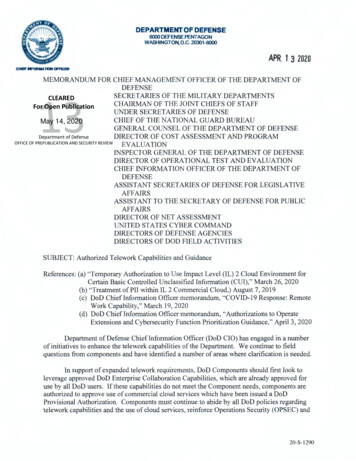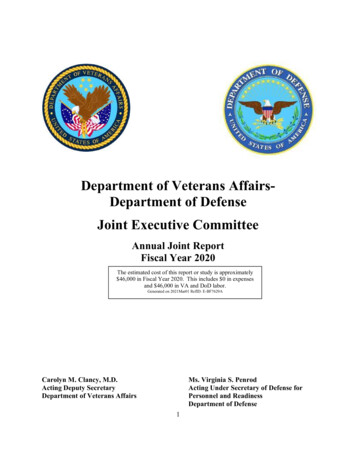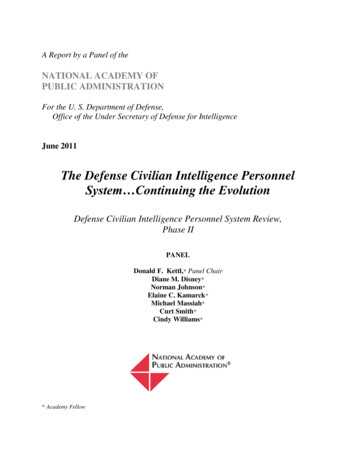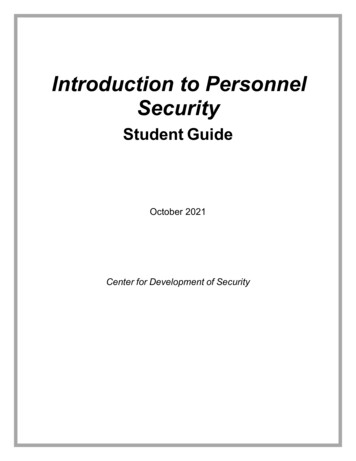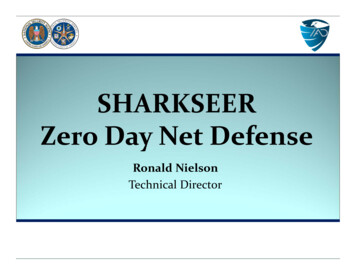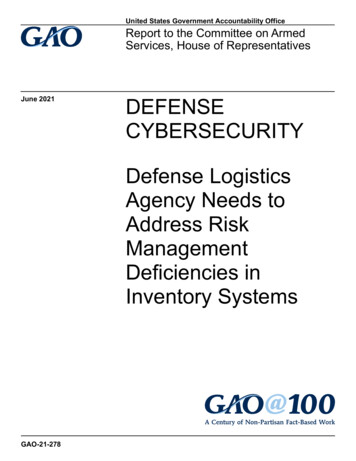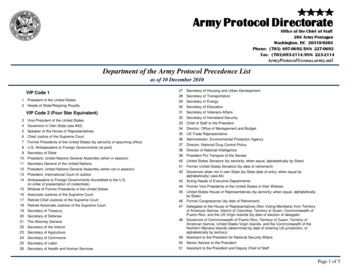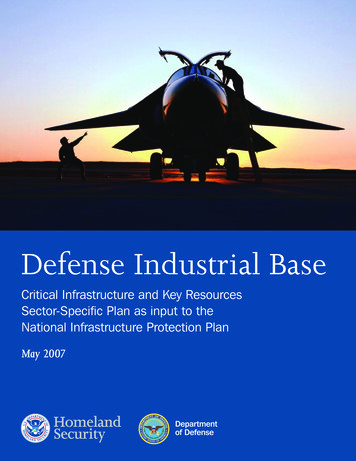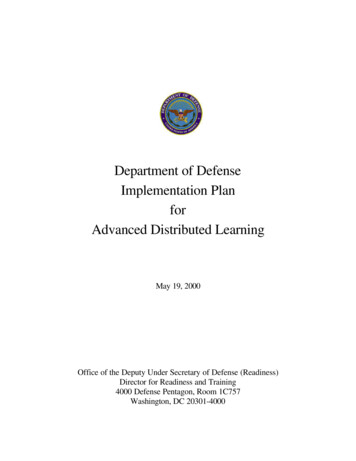
Transcription
Department of DefenseImplementation PlanforAdvanced Distributed LearningMay 19, 2000Office of the Deputy Under Secretary of Defense (Readiness)Director for Readiness and Training4000 Defense Pentagon, Room 1C757Washington, DC 20301-4000
Perspectives from Key Department of Defense Leaders“America's military services have a long tradition and a well-deserved reputation of world-classtraining. For example, having highly trained service members was key to our overwhelmingsuccess in Operation Desert Storm. We recognize that, as in the past, training will be the key toour success in future military operations. That is why training remains a high priority for the U.S.Armed Forces. It is the key to their readiness. It is the reason why our servicemen andservicewomen are the most capable in the world today. As good as we are at training, however,we are always vigilant in seeking opportunities to become better. The Department of Defense'svision is to ensure that Department of Defense personnel have access to the highest qualityeducation and training that can be tailored to their needs and delivered cost effectively, anytimeand anywhere.”William S. Cohen,Secretary of DefenseDepartment of Defense Training Technology Vision,provided to the Vice President of the United States,January 7, 1999“We have a department-wide strategy, Advanced Distributed Learning (ADL), which calls for thefull exploitation of technologies to support quality education and training in disciplines of nationalpriority. Key to this strategy is widespread collaboration with other federal agencies, academia,and the private sector. As a result of extensive cooperative efforts across the public and privatesectors, on January 31, 2000, my staff released an initial set of ADL specifications and guidelines.They will provide the foundation for leveraging learning technologies to prepare a skilledworkforce for the future. Outstanding opportunities exist for the public and private sectors towork together to enhance dramatically the quality of American education, the competitiveness ofits workforce, and the readiness of our military forces.”Rudy de Leon, Deputy Secretary of DefenseLetter to the Honorable John B. Larson,House of Representatives,April 18, 2000“Joint doctrine is the engine of change and is the foundation of all military operations. We aretransforming the joint doctrine development program to ensure that we get doctrine into thewarfighters’ hands in a timely manner. Technology will play a leading role in transforming jointdoctrine. The Internet and CD-ROM based distributed learning methodology employed toenhance doctrine awareness promises quality doctrine education to every member of the U.S.military. Information and hands-on training formerly available only to those people able toparticipate in resident education now will be available to all participants.”General Henry H. Shelton, Chairman Joint Chiefs of StaffStatement before the 106th Congress, Committee on Armed Services,United States Senate,February 8, 2000
Department of DefenseImplementation PlanforAdvanced Distributed LearningOffice of the Deputy Under Secretary of Defense (Readiness)Director for Readiness and Training4000 Defense Pentagon, Room 1C757Washington, DC 20301-4000
Table of ContentsPageES-1Executive Summary1.0 Introduction12.0 Implementing Responsibilities and Roles2.1Office of the Secretary of Defense2.2Department of Defense Components2.3Education and Training Steering Committee2.3.1 Total Force Advanced Distributed Learning Action Team2.3.2 Joint Services Collaborative Action Team2.4Joint Staff2.5U.S. Joint Forces Command2.6Military ional Guard Bureau2.8The Coast Guard11123334556789103.0 Implementing Common Specifications3.1Sharable Courseware Object Reference Model (SCORM) Background3.2Technical Working Group (TWG)3.3Sharable Courseware Object Reference Model Status3.4Setting and Implementing Courseware Standards3.5ADL Co-Laboratory3.5.1 Coordinate and Perform Research and Development3.5.2 Serve as a Test Bed3.5.3 Provide Learning Technology Demonstrations3.5.4 Provide a Database for Federal Training and Resource Center3.5.5 Provide a Resource Center and Help Desk Function3.6Examples of Recent Joint ADL Prototypes3.6.1 Joint Doctrine Training Model3.6.2 Joint Electronic Library3.6.3 Joint Doctrine Electronic Information System3.6.4 Doctrine Networked Education and Training3.6.5 Crisis Action Planning Tutored On-line Resource3.6.6 Joint Force Employment Interactive CD-ROM Wargame3.6.7 Joint Doctrine Operations Laboratory3.6.8 Joint Virtual Learning 2121
3.6.9 Future Joint Training System3.7Regional Centers Global Distributed Learning Data Services Network3.8Joint ADL Network Architecture4.0 Implementing Advanced Distributed Learning4.1 Task One – Identifying Requirements and Resources4.1.1 Readiness4.1.2 Program Review4.1.3 Data 4USAF4.1.3.5National Guard Bureau4.2 Task Two – Setting Goals and Milestones4.2.1Defense Courses for Conversion4.2.2Joint Staff4.2.3Joint Forces tional Guard Bureau4.3 Task Three - Monitoring and Measuring Progress4.4 Task Four - Establishing a Science and Technology 465.0 Implementation Issues and Potential Barriers5.1Education and Training Institutions5.2Collaboration cess5.7Information Security5.8Interoperable Learning Management System5.9Legislative535353535353535353546.0 Future Implementation Activities and Goals54Appendices:1Program Investment2Component Course Conversion Projection3Sharable Courseware Object Reference Model (SCORM)4Joint Advanced Distributed Learning Network Architecture57597280iv
56Joint Professional Military EducationGlossary8791List of FiguresFigure 1. Advance Distributed Learning Management Process2Figure 2. Evolution of Web-based Learning Technologies13Figure 3. ADL Co-Lab Concept of Operations16Figure 4. Joint Virtual Learning Environment (JVLE) Implementation Scenarios22Figure 5. Joint ADL Network Model24Figure 6. The National Guard’s “GuardNet XXI Network”34Figure 7. Current Goals for Course Conversion35Figure 8. DUSD (S&T) Focus on Cognitive Readiness46Figure 9. “ADL in 2012” Key Research Areas48v
vi
Department of Defense Implementation Plan forAdvanced Distributed LearningExecutive SummaryVision. The Advanced Distributed Learning (ADL) Initiative is providing a federal frameworkfor using distributed learning to provide high-quality education and training, that can be tailoredto individual needs and delivered cost-effectively, anytime and anywhere.Background. The Department of Defense (DoD) has developed its ADL Strategic Plan thatdescribes how it expects to use information, computing, and communications technologies tomodernize military education, training, and performance support. Importantly, the ADLInitiative’s underpinnings and applications are germane not only to the Department of Defense,but to other government organizations, academia, and the private sector, as well. The ADLInitiative, therefore, is a cooperative effort between the public and private sectors to developand share common standards, reusable learning tools, and content.The department’s education and training programs must prepare the total force to meet nationalsecurity challenges and opportunities. Training technologies, those available today as well asthose on the horizon, provide an opportunity to help us achieve that goal. We must be able totrain our forces effectively and rapidly, whether they are at home stations, en route, or in thetheater of operations. The tools under development through the ADL Initiative will add anotherlevel of learning capability and the opportunity to strengthen our already impressive inventory oflearning technologies, techniques, and procedures.The ADL Initiative, under which this Department of Defense Implementation Plan for AdvancedDistributed Learning has been developed, is a complex and dynamic undertaking. It is designedto meet the goals of the department, the Congress, and the Office of Science and TechnologyPolicy (OSTP), as well as the requirements of the warfighter and the DoD learner. ThisImplementation Plan is a living roadmap that will change over time.Top-Level Direction. This Implementation Plan describes Department of Defense’s approachto carrying out the “Department of Defense Strategic Plan for Advanced DistributedLearning” (a report submitted to the 106th Congress on April 30, 1999), and includesinformation about specific ADL prototypes, program milestones, and associated resources.The Strategic Plan provided initial answers to direction from Congress, the Secretary andDeputy Secretary of Defense, the Under Secretary of Defense for Personnel and Readiness, theOffice of Science and Technology Policy (OSTP), and the National Partnership for Reinventionof Government. Those directions, in sum, were to develop a Department of Defense strategyfor Advanced Distributed Learning (defined as education, training and performance support)ES-1
and assist the remainder of the U.S. Government in planning for the use of advanced distributedlearning technologies, tools and methodologies.This Plan is in consonance with Executive Order 13111, Using Technology to ImproveTraining Opportunities for Federal Government Employees (January 12, 1999), and withthe vision statements of the Secretary of Defense and the Chairman of the Joint Chiefs of Staff.It draws on assemblies of experts on education and training within the department, who havemet in multiple fora. Counsel has been sought and taken from both public and private sectors -academia, industry, and other government organizations. This Implementation Plan is based onresource expectations and may have to be modified to meet actual funding provided.Definitions and Terms . This Implementation Plan uses the following definitions and terms: Learning is defined as the acquisition of knowledge, skills, behaviors, and attitudes(through the integration of education, training, and performance support in acomprehensive, mutually supportive system).Distributed Learning (encompassing programs also referred to as distancelearning) is defined as structured learning that takes place without requiring the physicalpresence of an instructor. Distributed learning is synchronous and/or asynchronouslearning mediated with technology and may use one or more of the following media:audio/videotapes, CD-ROMs, audio/videoteletraining, correspondence courses,interactive television, and video conferencing.Advanced Distributed Learning is an evolution of distributed learning (distancelearning) that emphasizes collaboration on standards-based versions of reusableobjects, networks, and learning management systems, yet may include some legacymethods and media.Major Implementing Actions and Significant Accomplishments. There have been anumber of significant department-wide implementing actions since the department published itsStrategic Plan for Advanced Distributed Learning in April 1999. The Under Secretary ofDefense for Personnel and Readiness (USD(P&R)) has led a collaborative effort with theServices, Joint Staff, and other Department of Defense components to produce ADL policy,plans, and procedures for developing and implementing advanced distributed learningtechnologies across the department. The following specific actions have occurred over the lasttwelve months: Established the Education and Training Steering Committee. As part of the effort toprovide direction and oversight by senior leaders, the department established the Educationand Training Steering Committee to provide management policy oversight as well as aprocess to collaborate, to avoid redundancies, and to establish and monitor goals,objectives and guidelines.ES-2
Conducted Comprehensive Reviews of Distance Learning Programs . Thedepartment has conducted multiple reviews, as directed by the Deputy Secretary ofDefense, the Under Secretary of Defense for Personnel and Readiness, and the UnderSecretary of Defense (Comptroller), of existing distance learning programs, plans, resourcesand supporting data. Data developed as a result of these reviews are contained within thisImplementation Plan. These reviews highlighted the need for direct and continuousoversight and guidance by senior leaders as the ADL program matures. Reserve Component Distributed Learning. The Assistant Secretary of Defense forReserve Affairs (ASD/RA) chartered a Reserve Component Distributed Learning ProgramIntegrated Process Team (IPT) to assess legal and departmental policy impediments toimplementing advanced distributed learning practices for the reserve components. The IPT,comprised of ASD/RA and Active and Reserve Component personnel, has concluded itsnine-month study and has proposed the publication of department-wide policies that wouldprovide critical implementing guidelines for the reserve components’ distributed learningprograms. The policies would delineate how reservists could complete collective andindividual training and/or educational requirements via advanced distributed learningmethodologies. They would also “identify” what learning is “required” for ReserveComponent personnel who complete training or education approved for delivery viaadvanced distributed learning technologies. Co-Developed Common Internationally-Recognized Specifications . On January 31,2000, the Department of Defense released the Sharable Courseware Object ReferenceModel (SCORM) for public testing, evaluation, and comment. The release of the SCORMmarked the culmination of extensive cooperative efforts across the public and privatesectors. This common specification for instructional software will promote interoperabilityand reuse across the department, the federal government, academia, the private sector, andbeyond. The SCORM is a sine qua non -- a key technical enabler for advanceddistributed learning. Established the ADL Co-Laboratory. The department established the ADL CoLaboratory in Alexandria, Virginia in 1999 to foster partnerships, resource sharing, andlarge-scale collaboration. Its functions include promoting the collaborative research,development, and assessment of the common tools, standards, content, and guidelines forthe ADL Initiative. Its most critical function is to develop, evaluate, and promote ADLstandards, as directed by the President and Secretary of Defense. As the focal point for theSCORM specification, the ADL Co-Lab will provide a forum and technical support fordeveloping and assessing prototype tools and content that adhere to the evolvingspecification. Expanded the ADL Co-Laboratory Structure. Two ADL Co-Lab nodes have beenestablished, in Orlando, FL and Madison, WI. The Joint Co-Lab node in Orlando wasestablished to promote collaborative and rapid development of ADL prototypes and ADLES-3
system acquisitions, principally among the department’s training systems developmentcomponents. In January 2000, an “independent” ADL Co-Lab was established, inpartnership with the University of Wisconsin System and the Wisconsin Technical CollegeSystem, to promote collaborative development, demonstration, and evaluation of nextgeneration learning technologies that enable distributed learning, principally among academicinstitutions. All three Co-Labs work together to share research, subject-matter expertise,common tools, and course content through a virtual ADL Co-Lab network. Issued Challenge to Collaboratively Develop Prototypes. On March 28, 2000, USD(P&R) announced to the Department of Defense components the release of the SharableCourseware Object Reference Model (SCORM) and challenged the department’seducation and training developers “to work collaboratively, across the department,academia, and the private sector, to develop ADL prototypes and content that conform tothe new SCORM specification.” Provided Incentives for Collaborative Development of ADL Prototypes. In January2000, the Joint Co-Lab issued a “focus call” for ADL prototype proposals. Twenty-nineproposals were received from education and training developers across the department.Incentive funds were awarded in April 2000 to the nineteen proposals that placed thegreatest emphasis upon collaboration and adherence to the new SCORM specification.ADL prototype developers will demonstrate the interoperability and reuse of their ADLcourse modules at a number of “plugfest” or interoperability demonstrations to be hosted bythe ADL Co-Labs throughout the year. Issued Defense Planning Guidance. In the FY 2002-2007 Defense Planning Guidance,the Secretary of Defense directed the Department of Defense components to: develop andmaintain strategic training plans that guide Department of Defense training programs anddemonstrate how they take full advantage of learning technologies to provide traininganytime and anywhere; identify in their Program Objective Memoranda, in specificdistributed learning Program Elements, all distributed learning programs and resources,including research and development; and develop coalition-based global education andtraining opportunities through the ADL Initiative. Defined an ADL Science and Technology Program. As part of the department’s“Cognitive Readiness” Science and Technology Focus Area, the Deputy Under Secretaryof Defense for Science and Technology reviewed and studied the department’s keyresearch to accelerate the development of the Department of Defense’s ADL capability andto develop a research agenda to produce that capability by the year 2012. This analysisidentified four key research areas that address the full spectrum of educational designactivities, including requirements analysis and course development, as well as delivery andassessment. The four areas are intelligent computer-aided instruction, authoring tools,distributed simulations, and dynamic learning management.ES-4
Provided a Report to the Presidential Task Force on Federal Training Technology.In response to Executive Order 13111, the Department of Defense led a collaborativeeffort with other federal agencies and the private sector to develop common specificationsand standards for technology-based learning that could be used to support federal andnational education and training needs. The department provided a final report, entitled“Establishing a Federal Framework For Distributed Learning,” to the President’s TaskForce on Federal Training Technology in March 2000. In addition to making the SCORMspecification available to other federal agencies, this report encouraged the federal agenciesto participate in collaborative development efforts through the ADL Co-Laboratory inAlexandria, Virginia.Future Activities and Goals. Department of Defense’s current focus is to work through itsEducation and Training Steering Committee to set scheduling goals for the next two years forconverting courses, as identified by the components, in accordance with the ADL SCORM. Inparallel we will continue to seek the support of key leaders throughout the department to assistin adopting and mandating key and challenging transformational actions as we create the futurelearning environment -- one that is learner-centric and where knowledge is available anywhere,anytime. An essential element of this process will be the continuing development of specificADL learning prototypes to demonstrate the efficiency and effectiveness of advanceddistributed learning in achieving the Secretary’s vision. The department will be making plannedimprovements to the SCORM, facilitating its adoption by the appropriate internationalstandards-granting organizations as a standard, and assisting its incorporation into commercialproducts. The ADL Co-Laboratories will play an essential role, by helping others incorporateADL compliance into the design of course content and by assessing the costs and benefits ofADL-compliant prototypes.Key Goals and MilestonesSpring to Winter 2000 Conduct a series of “plugfest” events to test, validate, and refine the SCORM Complete development of SCORM compliance-testing software Encourage collaborative development across the Department of Defense, academia, and theprivate sector through active involvement in the ADL Co-Labs Encourage voluntary compliance with the SCORM in course development Encourage vendors to incorporate SCORM V1.0 into their next product cycle Release Version 2.0 in early Fall 2000 Work with standards groups for SCORM adoption Staff a plan for joint DL architecture Complete the development of SCORM ADL rapid-prototypesWinter 2001 Assess whether there should be an acquisition policy decision for mandatory compliancewith SCORMES-5
Winter 2008 All existing courses slated for conversion are SCORM-compliantWinter 2010 Joint Vision 2010 goal of achieving “information superiority” is enabled through an ADLcapability of providing the right information and knowledge anywhere, anytimeThe Big Picture - ADL in Context. The ADL Initiative is the Department of Defense’sprincipal vehicle for developing a broad range of plans and programs that use advancedcommunications and learning technologies to modernize how we will educate and train U.S.armed forces.As mentioned at the outset, ADL’s primary goal is to implement the Secretary of Defense’straining vision -- to provide access to the highest quality education and training that can betailored to individual needs and delivered cost-effectively, anytime and anywhere. Theunderpinnings of ADL are germane to other government organizations, academia, and theprivate sector as well. As such, the department has designed the ADL Initiative to be acollaborative effort between the public and private sectors to develop the common standards,tools, and learning content that are critical to the future learning environment.Advanced technologies are changing how people live their lives and do business -- not justhow they learn. Moreover, the pace of technological change is expected to remain extremelyrapid for the foreseeable future. This presents a challenge to the department as it strives toapply learning technologies cost-effectively. While we have made enormous progress in a shortperiod of time, we are committed to accelerating that progress.If we are to rely heavily on networked communications, we must ensure security and protectpersonal privacy. If learning objects are to be shared, reused, and marketed, we must protectintellectual property rights. If we are to take full advantage of such technologies, we mustfundamentally change how we do business; and this means we must change organizationalstructures, reengineer budget processes, and provide incentives to enable and motivate change.The department recognizes that the power to learn (through education, training, andperformance support) is critical to making U.S. service members and armed forces ready tocarry out their missions. This “Department of Defense Implementation Plan for AdvancedDistributed Learning” reflects the department’s commitment to building the learning environmentof the future.ES-6
Department of Defense Implementation Plan forAdvanced Distributed Learning1.0IntroductionThe purpose of the Department of Defense Implementation Plan for Advanced DistributedLearning is to apply the Department of Defense Strategy for ADL to meet the needs of the U.S.Armed Forces for the next millennium and to address the specific directions and focus providedby various mission-need statements. The capabilities needed in our Armed Forces of the futureare most clearly defined in the Secretary of Defense's Training Technology Vision, theChairman of the Joint Chief's Joint Vision 2010 (JV 2010), and Joint Professional MilitaryEducation 2010 (JPME 2010). The goals of these vision statements are further explained andunderscored by Executive Order 13111 and congressional tasking. They have provided thewhy; this Plan provides the how much, when and how.2.0Implementing Responsibilities and Roles2.1Office of the Secretary of Defense. The Deputy Under Secretary of Defensefor Readiness is responsible to the Secretary of Defense for department policy involvingmilitary education and training. The Director of Readiness and Training is responsible forand shall manage oversight of the Department of Defense components’ (organizations andcommands subordinate to the Secretary of Defense) implementation of this Plan and theStrategic Plan that together make up the department’s strategy for training readiness in theJV 2010 environment. The Deputy Under Secretary for Readiness is responsible forestablishing and chairing a Department of Defense Education and Training SteeringCommittee (ETSC), hereafter referred to as the Committee, composed of one general orflag-officer each, from the Joint Staff, the Joint Professional Military Education System,United States Joint Forces Command, each military service, the United States MarineCorps, United States Coast Guard, each reserve component, selected Defense Agenciesand selected members from the staff of the Secretary of Defense. The purpose of theCommittee is to provide executive policy and programmatic oversight and guidance for thedepartment’s implementation of ADL and the creation of an anywhere, anytime learningenvironment.2.2Department of Defense Components. The Department of Defense componentsand the military services are responsible for identifying and documenting requirements andresources needed to implement ADL initiatives within their respective service, Joint, orAgency organizations, for implementing their ADL Programs, and for working with otheragencies to identify opportunities to share products and lessons learned, and leverageresources. The military services are responsible for appointing a general or flag rank officerto sit on the Education and Training Steering Committee (ETSC) to represent his/hereducation and/or training component of that service in all matters that come before the1
Committee. The Director of the Joint Staff is responsible for appointing a Joint Staff generalor flag-rank officer to sit on the Committee to represent the Chairman of the Joint Chiefs ofStaff (CJCS) and is responsible for appointing a general or flag-rank officer from the JointProfessional Military Education System to represent the Joint Professional MilitaryEducation (JPME) community. The Commander-in-Chief, United States Joint ForcesCommand is responsible for appointing a general or flag-rank officer to sit on theCommittee as a representative of the joint community in accordance with the UnifiedCommand Plan.2.3Education and Training Steering Committee (ETSC). The Committee willadvise and assist the Secretary of Defense on all aspects of Advanced Distributed Learningwith the goal of ensuring that Department of Defense personnel have access to costeffective, high-quality education and training, tailored to needs, whenever and whereverrequired. The Committee is expected to meet quarterly to collaboratively integrate theefforts of the organizations and headquarters supporting service or Joint, individual andcollective training and education (service, Joint or Agency-specific institutional training orprofessional education). The first meeting of the Committee occurred February 23, 2000.This initial meeting provided an opportunity to hear and to integrate the representative viewsand perspectives of the Interservice Training Review Organization (ITRO), the militaryservices’ senior service training officials, and the Military Education CoordinationConference (MECC), the body responsible to the Chairman of the Joint Chiefs of Staff forJoint Professional Military Education.ADL Management ProcessIndustry ForumDUSD(R)Federal ForumEducation and Training Steering CommitteeTotal Force Advanced Distributed LearningAction TeamTechWrkgGrpJoint Services CollaborationAction TeamADL Co-LabFigure 1. Advanced Distributed Learning Management Process2
2.3.1 Total Force Advanced Distributed Learning Action Team. The Committee willuse the standing Total Force Advanced Distributed Learning Action Team (TFADLAT) asits working group to advise and assist the Committee on the institutionalization of theAdvanced Distributed Learning Initiative. A DUSD(R) representative chairs theTFADLAT, which has membership from each service, each reserve component, the JointStaff, OSD, U.S. Joint Forces Command, and Defense Agencies. The TFADLAT advisesand assists the Secretary of Defense, Joint Staff, Services, and Defense Agencies on allaspects of advanced distributed learning. The TFADLAT: Serves as the Department of Defense focal point for advanced distributed learningpractices and procedures;Provides oversight of advanced distributed learning content and coursewaredevelopment and implementation;Provides a forum for discussion and resolution of practical issues in advanceddistributed learning;Drafts, reviews, researches, evaluates, coordinates, and recommends policies for theEducation and Training Steering Committee;Recommends funding and Research and Development priorities; and,Promotes collaboration.2.3.2 Joint Services Collaboration Action Team. The Committee will use the newlyproposed Joint Services Collaborative Action Team (JSCAT) to identify courses or contentthat can be developed collaboratively and shared across the Department of Defenselearning community to avoid duplication and reduce costs. JSCAT membership will consistof one representative from each military service and other Department of Defensecomponents that are developing ADL courseware and content. The JSCAT will appoint arepresentative to the TFADLAT to advise them on an agreed-upon list of courses that areplanned and programmed for conversion by the Department of Defense components. TheJSCAT will also provide this report to the
List of Figures Figure 1. Advance Distributed Learning Management Process 2 Figure 2. Evolution of Web-based Learning Technologies 13 Figure 3. ADL Co-Lab Concept of Operations 16 Figure 4. Joint Virtual Learning Environment (JVLE) Implementation Scenarios 22 Figure 5. Joint ADL Network Model 24 Figure 6. The National Guard's "GuardNet XXI .
